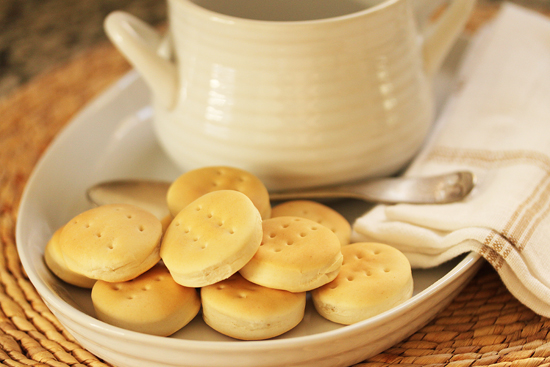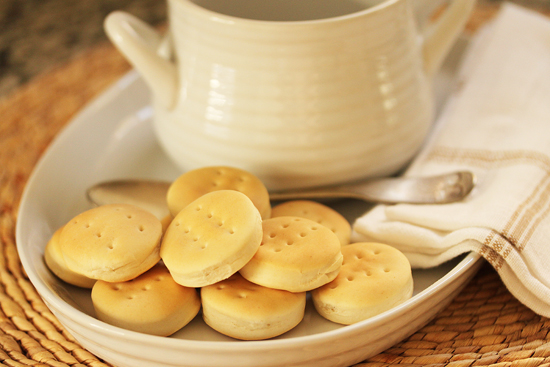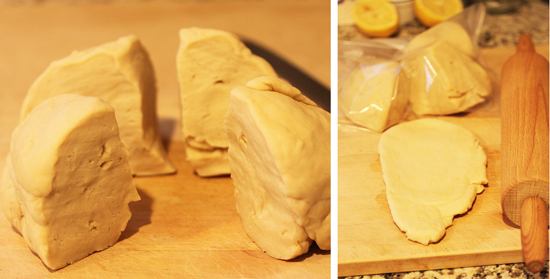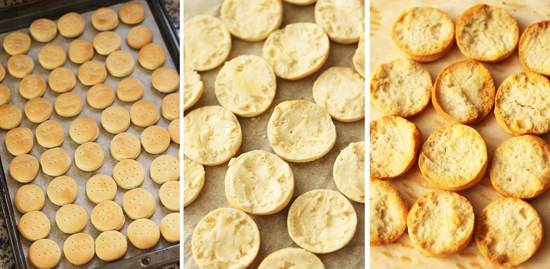
When I was writing my post about New England Clam Chowder, I kept running across the instructions that it should authentically be served with Common Crackers. I had no idea what they were. After all, I grew up in Minnesota, lived in Chicago and moved to L.A., where I have been ever since. I went to Boston for a weekend once, and touched down at the Bangor, Maine, airport on my way to Europe in 1976. But I never ran into any common crackers in my travels.
And then I recalled a recipe I had filed away back in the day for some kind of New England cracker and, after a huge search in my file cabinet, Eureka! I found it and it was for the Common Cracker! God, I’m good. Anyway, there was no picture for what they looked like, so I looked on-line and discovered that Common Crackers were first made in Vermont in 1828. Over the years, nationwide, they became the standard symbol of the country store. No rural store was complete without the “cracker barrel” near the cheese counter where people would have casual conversations and idle talk (I think it’s called gossip). Families would buy these crackers by the barrel, containing about 1,200 crackers, which would last a year stored in a handy place for frequent family eating. Common crackers were crumbled into cold milk for supper or a snack with a hunk of cheddar cheese on the side. There are stories about a game played by people waiting for the evening stage. Each would eat a dry cracker and see who could whistle first.
Julia Child once wrote, “As any New Englander knows, you can’t enjoy a real New England chowder without toasted common crackers.”
The first step was to make a yeast/flour starter which sits at room temperature for 24 to 60 hours. I didn’t photograph this step. The batter got big bubbles, doubled in size, then collapsed and separated into solid and liquid. It was also dynamic and exciting as the gas produced blew the cover off twice with a loud pop. Next a mixture was made of shortening, potato flakes, brown sugar, baking soda, lemon juice and water. You can see it in the photo above left. A cup of the starter was mixed with flour with fork and kneading, and rested for an hour in the middle photo above. And last the shortening mixture was kneaded into the starter ball in a KitchenAid and another cup of flour added, to make a stiff ball.
The ball of dough was quartered and one part rolled out to 3/8-inch thickness.
The sheet of dough was run through a pasta machine on the widest setting and folded in thirds letter-style a total of six times. A 1 ¼-inch biscuit cutter was used to cut circles of dough and placed on a sheet pan.
The recipe made 108 little firm puffy crackers for me, a bunch of which I split with a sharp little knife, buttered liberally and toasted under the broiler until they turned a lovely golden brown color. Do not make the mistake I made by tasting these little buttery beauties, because you cannot eat just one. They are absolutely addicting. Just crumble them up in your clam chowder. You’ll be so happy you did.
 Print Recipe
Print Recipe
Homemade New England Common Crackers
Adapted from a recipe by Kathleen Annino
Makes about 100 crackers
Equipment
Rolling pin
Kitchen Aid or other heavy-duty mixer
Paddle and hook attachments for mixer
Hand-cranked pasta machine
Ingredients for Yeast Starter
1 ½ teaspoons active dry yeast
1 cup warm water (105*F to 110*F)
1 tablespoon light brown sugar
1 ½ teaspoon fresh lemon juice
½ teaspoon kosher salt
1 cup bread flour
Ingredients for Cracker Dough
1 cup yeast starter
1 to 1 ¼ cups bread flour
6 tablespoons (3 ounces) vegetable shortening or lard
1 teaspoon kosher salt
1 tablespoon instant potato flakes
1 tablespoon light brown sugar
½ teaspoon baking soda
3 tablespoons water
1 tablespoon fresh lemon juice
An additional 1 ½ to 2 cups bread flour
Instructions
1. Make the starter: Whisk together the yeast, water, brown sugar, lemon juice and salt in a large bowl. Whisk in the flour to make a batter.
2. Transfer batter to a large container with a snap-on cover and set out at room temperature for 24 to 60 hours until it rises and forms large bubbles. If left long enough it will deflate and separate. This is ok. The gases formed may blow the cover off. Just put it back on.
3. Make the cracker dough: Put 1 cup of starter in a large bowl and sprinkle with the 1 cup of flour. Begin incorporating the flour with a fork and finish with your hands, kneading it in the bowl. Cover and let rest for 1 hour.
4. In a separate bowl, mix together with a fork the shortening, salt, potato flakes, brown sugar and baking soda. Mix in the water and lemon juice, mixing thoroughly until very little water remains in the bowl.
5. Place the dough ball in the bowl of a Kitchen Aid or other heavy-duty mixer with the paddle attachment. Add the shortening/water mixture and knead it into the dough ball on medium speed.
6. Gradually add the additional 1 ½ cups flour, switching to the dough hook as the dough stiffens. Knead on medium speed with the hook for about 5 minutes until you have a smooth ball. You may need to stop and reposition the dough ball onto the hook.
7. Cut the dough ball into quarters and put three of them in a zip-lock bag so they don’t dry out.
8. With a rolling pin, roll one piece of dough into a rectangle 3/8-inch thick. Put through rollers on pasta machine on widest setting, starting with a short end.
9. Fold rolled dough into thirds like a business letter, pressing layers together slightly with your fingers. Give the dough a quarter turn and roll again. Repeat folding and rolling a total of six times. The final dough sheet should be no thicker than ¼ inch.
10. Preheat oven to 425 degrees F. Line two baking sheets with parchment paper.
11. Cut 1 ½-inch rounds from the rolled dough and place on baking sheet ¼ inch apart. Repeat with remaining 3 quarters of dough. Reserve excess dough scraps from cut-out in zip bag after each quarter is rolled out.
12. Form the four leftover dough scraps into a ball, roll out as with previous quarters.
12. Bake dough rounds for about 8 minutes, until they have risen, are light brown and firm to the touch. Set first baking sheet aside while you bake the second sheet. When it is finished baking, set second sheet aside.
13. Reduce oven temperature to 200 degrees F. Place the two sheets back in oven and dry out the crackers for about 2 hours.
14. Store in an airtight container when completely cool. Re-crisp in a 400 degree F oven for 5 minutes if necessary.
Note: For traditional use, split the crackers in half with a small sharp knife, spread with butter and toast under the broiler, then crumble into chowder.









![versatilebloggeraward[1]](https://cookandbemerry.com/wp-content/uploads/2010/09/versatilebloggeraward11.jpg)

{ 1 trackback }
{ 9 comments… read them below or add one }
I just pinned these for later (Pinterest.com), they look fabulous. Great pictures, too. Thanks for the recipe.
I love the idea of making crackers from scratch! Definitely giving this recipe a try next time I make soup or chowder 🙂
Those look fantastic!
These look fantastic, I love the history too. I will look for them in a country store unless my kids will be old enough to make them with me before I go to NE.
I love seeing the food connection across regions! What you call common crackers are what Kentuckians call ‘beaten biscuits.’ Most people won’t make them from scratch, because the traditional recipes call for them to go through 20 rounds of beating with a rolling pin! (That was before they came out with pasta rollers and biscuit brakes, of course.) Instead, most folk buy them from the Jackson Biscuit Company. http://www.jacksonbiscuit.com
Thanks for posting this!
Oh wow… they look good, but I’ve been a New Englander my entire life and have never come across these. Oyster crackers, sure, but I have no clue what these things are. I imagine they’d be divine in clam chowder though 🙂
These are the kind of recipes I truly treasure…the ones with a history behind them! Thank you for sharing your creation with me! From first word to last, I was glad I visited you and your site today. I hope this finds you happy and well. Much love.
Wow, how common are they when I’ve never heard of them? They look like a mini version of these ones my dad used to eat called Royal Lunch Crackers in a purple box. They were his, and we weren’t allowed to eat them. But I’d rather have yours!
Hey Lynne!
My office hosts a “quarterly cracker barrel” with the corporate CEOs… it’s one of the few times a year we get to see the big people. 🙂 I was always curious how the “Cracker Barrel” got it’s name, so thank you!
I’m a lover of clam chowder – next time, I need to make these crackers.
[K]